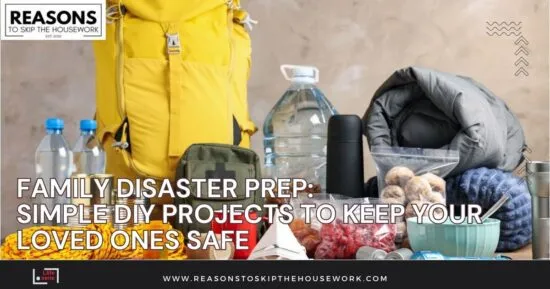
We all love the easy kind of projects… fixing a leaky tap, painting a shelf, making something simple with the kids on a Saturday afternoon. But there’s another kind of “project” that matters more than we like to think about: getting your home and family ready in case something goes wrong.
Storms, floods, wildfires… they don’t always come with much warning. And they don’t just happen somewhere else. A bad storm can knock out power miles inland, and a flood can start from just a few hours of rain.
Preparing doesn’t mean living in fear. It means you’ve done what you can, so if the day ever comes, you’re not starting from zero. And the truth is, a lot of those steps can be done together: small, practical things that also teach your kids skills they’ll probably remember forever.
Contents
Start with a Family Meeting
Children notice more than we think. If the grown-ups are tense, they feel it too. Rather than speaking in whispers about possible disasters, bring them into the conversation. Use language they can understand to explain what might happen—whether it’s a storm, flood, wildfire, or earthquake—and reassure them that having a plan makes everyone safer.
Make a simple to-do list together and let each person choose a task. Younger kids can help by labeling bags, gathering small items, or drawing a simple map of the home. Older children might take on jobs like checking supplies or helping organize the emergency kit.
It’s also important that everyone knows the communication plan. Decide on a safe meeting spot if the family gets separated. Choose an out-of-town contact that each person can reach. Write important phone numbers on cards and keep them in backpacks or wallets—so the information is there even if devices can’t be used.
Teaching children to think beyond their own safety is just as important. You might explain how certified organisations like the American Red Cross hurricane relief help families who can’t prepare on their own, and even involve your kids in choosing items to donate or setting aside extra supplies for a neighbor. It’s a small way to show that caring for the community is part of the plan too.
Build a DIY emergency kit
Putting together your own kit saves money and helps kids learn what’s inside. Gather the following items and store them in a sturdy bin or backpack in an easily accessible spot:
- Water and food: One gallon per person per day and non‑perishable snacks like granola bars, canned beans and peanut butter. Don’t forget a manual can opener.
- Light and power: Flashlights or headlamps, extra batteries and glow sticks for entertainment.
- First aid: Bandages, antiseptic wipes and any prescription medications. Rotate out expired items.
- Hygiene: Hand sanitizer, wet wipes and sturdy gloves.
- Comfort: Small toys or card games. Familiar objects ease stress during an emergency.
Let kids help choose their favorite snacks and comfort items. Turn supply hunting into a scavenger hunt.
Prep your home together
Home readiness doesn’t have to be daunting. Turn these chores into weekend projects:
- Secure the outdoors: Walk around the yard and put away or tie down patio furniture and potted plants. Give younger kids a checklist and a small wagon to help move items.
- Check windows and doors: Inspect for cracks. Teach older kids how to apply weather stripping or caulk. Storm shutters are a smart investment if you live in a hurricane‑prone area.
- Clean gutters: This messy chore helps prevent water backing up. Reward your helpers with popsicles afterward.
- Create a blackout box: Fill a shoe box with candles, matches (out of children’s reach), board games and a battery‑powered radio. Label it clearly so you can grab it when the power goes out.
Kitchen prep: Cooking for a storm
Even if you lose power, you’ll need to eat. Prepare a “no‑cook menu” together: assemble sandwich bags with trail mix and dried fruit; bake granola bars that keep well without refrigeration; freeze water bottles to keep food cold and melt for drinking. Cooking together offers a sense of control and comfort. Label everything with dates and rotate supplies every six months.
Teach safety skills
Empower older kids by teaching them how to turn off utilities. Show them where the main water valve and electrical breakers are. Discuss what to do if a window breaks during a storm: get to a windowless interior room, use pillows or mattresses for protection and stay away from glass.
Stay informed
Sign up for local emergency alerts and download a reliable weather app. Show children how to listen to a battery‑powered radio for updates. Explain terms like “watch” versus “warning.” Knowledge reduces fear because surprises are scarier than storms you see coming.
Conclusion
Skipping the housework to craft and cook is fun, but skipping hurricane prep isn’t an option. By turning safety tasks into manageable, even enjoyable projects, you protect your family and empower your kids. Hurricanes may be getting stronger, but a little DIY effort goes a long way toward peace of mind. And once your kits are packed and your yard secured, you’ll have earned that relaxing afternoon in the craft room — storm or shine.
